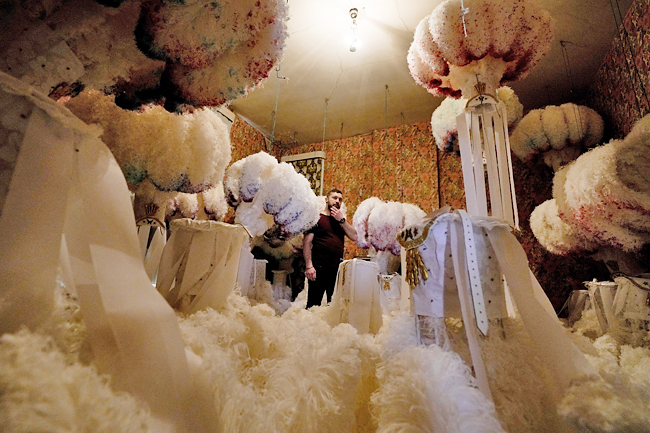BINCHE, BELGIUM (AP) – On a sunny winter morning heralding a radiant Mardi Gras, Beatrice and Karl Kersten don’t have a minute to spare.
In their warm workshop decorated with ancestral photos, the couple bend over their sewing machines. They are busy putting the finishing touches to the delicate lace details adorning the carnival costumes that will send a whole town into rapture once paraded through the cobbled streets of Binche.
“It’s a total rush, we are late,” said Karl, a fourth-generation tailor.
But to the Kerstens and their son Quentin, now in charge of the family business in the medieval western Belgian town, this year the pressure feels really good.
After a two-year hiatus due to the coronavirus pandemic that brutally brought one of Europe’s oldest Mardi Gras celebrations to a halt – and the Kerstens to the verge of bankruptcy – celebrations are back with a vengeance this winter.
“There is a real excitement and enthusiasm,” said Quentin. “People came much earlier to reserve their costumes than in other years.”
The earliest records of the Binche Mardi Gras, which draws thousands of revellers, date to the 14th Century. Many Belgian towns hold ebullient carnival processions before Lent. But what makes Binche unique are the “Gilles” – local men deemed fit to wear the Mardi Gras costumes.


Under rules established by the local folklore defense association, only men from Binche families or resident there for at least five years can wear the Gille costume. Other characters – the Peasant, the Sailor, the Harlequin, the Pierrot or the Gille’s Wife – also play a role in the carnival.
The UNESCO-listed event starts three days before Lent and reaches its climax on Mardi Gras, when the Gilles – in wax masks sporting green spectacles and thin moustaches – dance in their wooden clogs to the sound of brass instruments and clarinets until the early morning hours. Women can join in, but only men wear the Gille outfit.
“The carnival is really the soul of the city of Binche, so we have been really sad over the past two years” said Patrick Haumont, a town hall staffer who often takes part in the celebrations, dressed in the red, yellow and black attire.
Over the past three weeks, rehearsals for the main parade have attracted more participants than usual. And at weekends, excitement in the bars filling the town’s main square hits unprecedented levels.
“Instead of the one beverage you would normally drink, it’s now five,” Haumont said.
After the economic struggles of the pandemic years, and amid pain from energy bills that went through the roof after Russia’s invasion of Ukraine, the people of Binche want to make this year’s carnival one for the ages.
Although taking part requires a big financial commitment – renting a Gille costume and a lavish ostrich-feather hat costs around EUR300 (USD327) – some 1,000 Gilles are expected to parade through the narrow streets of brick row houses to the beat of the drum and the tinkling bells of their outfits.
“People have rented more costumes, more hats. Everybody wants to do it again. We can see that there is a need,” Haumont said.
For Christian Mostade, an 88-year-old member of the biggest Gilles company, it will be his 38th carnival as a Gille.
“In normal times, we would be around 140 or 145,” he said. “This year we’ll be 158. There are old-timers who have not participated for a long time who have returned, and also many new ones.”
Charly Rombaux is among the newcomers. The 35-year-old delivery driver does not want to wear the daunting traditional hat that weighs nearly four kilogrammes for his grand debut as a Gille.
The experienced Mostade had the solution pat.
“The solution is to find three men in your company with the same head size, so you can alternate with the hat on,” Mostade said.
That need to get together again in a city where the Carnival creates a unique sense of belonging is a relief for the “louageurs” – the craftsmen making the costumes and renting them to the Gilles.





